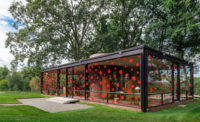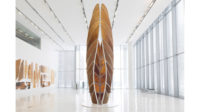Yayoi Kusama’s ‘Cosmic Nature’ Delights at NYBG

Dancing Pumpkin, Yayoi Kusama
Photo © Danica O. Kus

Dancing Pumpkin, Yayoi Kusama
Photo © Danica O. Kus

Ascension of Polka Dots on the Trees, Yayoi Kusama
Photo © Danica O. Kus

Narcissus Garden, Yayoi Kusama
Photo © Danica O. Kus




If you’ve always wanted to see a 16-foot-tall yellow pumpkin, now’s your chance to visit Yayoi Kusama’s artworks at New York Botanical Garden (NYBG) in the Bronx, on view now through October 31, 2021. Called KUSAMA: Cosmic Nature, the exhibition features 60 works by the 92-year-old Japanese artist.
The most impressive part of Cosmic Nature, designed by guest curator Mika Yoshitake, is the sheer scale. There are towering maple trees, wrapped in red-and-white polka dot fabric, and aptly titled Ascension of Polka Dots on the Trees, and 1,400 floating stainless steel spheres in a pond at NYBG’s Native Plant Garden for Narcissus Garden (which Kusama debuted at the 1966 Venice Biennale). But within the vast context of the botanic gardens’ 250 acres, one seems to simply stumble upon them.
Set in a cluster of birch trees, like those of the artist’s childhood home in Nagano, Japan, is a 16-foot-tall steel sculpture called Dancing Pumpkin that truly stands out. The new work, which is architectural in form, is painted yellow with patterned black polka dots. Visitors can walk underneath and through its dark petaled arches (the underbelly of the sculpture is painted a lacquered black), which peel down from the pumpkin’s center stem, in a surreal pavilion-like setting. Three of these petals reach the ground to anchor the work, while the rest hover just above it, enveloping the visitor.

My Soul Blooms Forever, Yayoi Kusama. Photo © Danica O. Kus
The stark contrast of these bold colors against black is a theme repeated often in Kusama’s works, and which stems from the artist’s obsession with nature and eternity. In Cosmic Nature, with several colorful sculptures rising from inky still water, this darkness juxtaposed with the lush greenery perhaps references the abyss implied in infinity.
“Our earth is only one polka dot among a million stars in the cosmos. Polka dots are a way to infinity,” said the artist in an exhibition quote.
Whimsical indeed, the exhibition is more childlike than those of past years but certainly a bright spot welcome now more than ever after a long, dark winter. The exhibition, which opened on April 10, was intended to open in 2020 but was postponed due to the coronavirus pandemic.








